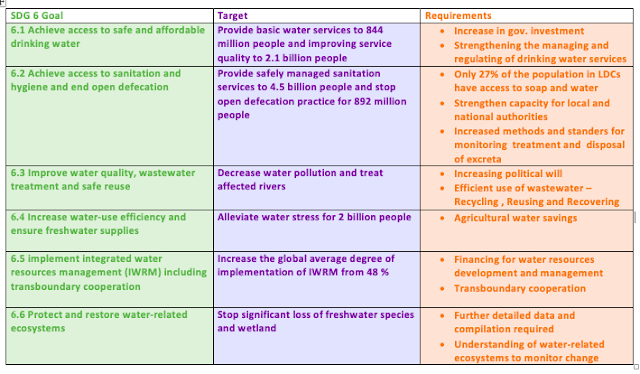A Sustainable Future to Water Sanitation
Over the past weeks, I have raised the issues of poor water quality, water privatisation, social innovations, colonisation and cholera, all key factors in understanding the improvement of access to clean water and sanitation. I have realised growing up with a flushable clean toilet, which I previously presumed a right I now know is most definitely a privilege we take for granted. This final blog will look at the Sustainable Development Goal exploring the future to Africa's water sanitation.
I begin this exploration in a sustainable future by focusing on the MDG goal 7 - "To halve the population of the universal population without sustainable access to clean and safe drinking water and basic sanitation by 2015" (MDGmointor, 2016). The MDG has received much criticism for not meeting this proposed target in a time of the proposed deadline. In a review by Weststrate et al., 2018 the study exposed that the indicators for the MDG lacked the following considerations:
- Failure to take water quality into account
- Taking into account water quality as an indicator, the population that was accessed with sustainable access to safe water decreases dramatically.
- Failure for Disease Prevention - safe collection, treatment and disposal of wastewater
- Lack of targets and indicators of wastewater treatment & integrated water resource management
- Lack of consistent data monitoring
- Failed to encourage national and local government support
- An example of this is in Zambia where the government do not allocate sufficient funding to the improved water and sanitation projects and those projects that do get authorised by the government less than a quarter actually are implemented.
Following from the MDG the Sustainable Development Goal 6 - to ensure availability and sustainable management of water and sanitation for all by 2030 (UN, 2018) was proposed. The SDG works to address all the above failures of the MDG by including added dimensions such as affordability, water quality and accessibility (Weststrate et al., 2018).
Is the SDG on track?
In the latest 2018 SDG implementation report which can found here, the report states that SDG 6 is NOT on track to be achieved by 2030. Using the information from the report, I have created a summary table (Table 1) which displays the Targets and Requirements in SDG 6:
 |
| Table 1: Table to show 2018 Review of SDG implementation. Source: Sustainble Development, UN, 2018.
What is the
Future?
Following the above, it is clear
that the future for water sanitation is uncertain. Financing and
government support are reoccurring themes in the report which can help to
achieve the goals which have been set out by 2030. Carter et al., 1999 article on water
sanitation sustainability highlights the need for motivation, maintenance, cost
recovery and continuing support. Motivation can relate to not only stakeholders
and government but also towards the locals. Education and hygiene
promotion can increase awareness of the challenges facing the poorest of
communities. The use of social media I think has helped greatly in spreading
the issue of water sanitation, this is done through talks, Twitter and blogging
which can provide a platform to place pressure on those who can provide the
support and finances needed to address the sustainability of water sanitation
for all.
I finish blog with the statement
which I personally found most powerful:
"Access to water and clean water is
defined as an essential HUMAN RIGHT -indispensable to our
human health, dignity and prosperity" UN, 2014
|

Comments
Post a Comment